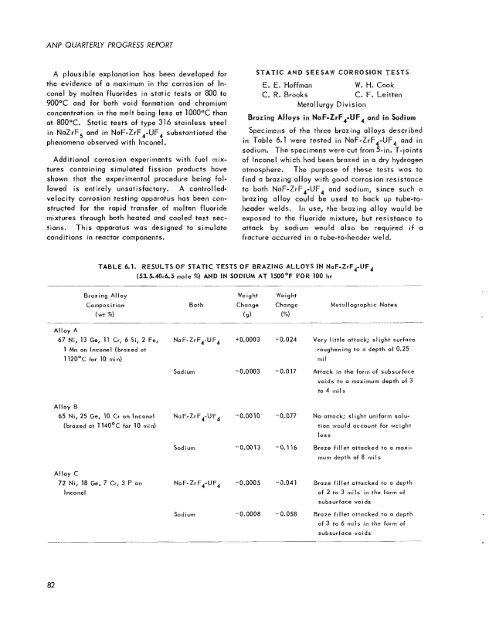ORNL-1771 - Oak Ridge National Laboratory
ORNL-1771 - Oak Ridge National Laboratory
ORNL-1771 - Oak Ridge National Laboratory
Create successful ePaper yourself
Turn your PDF publications into a flip-book with our unique Google optimized e-Paper software.
ANP QUARTERLY PROGRESS REPORT<br />
A plausible explanation has been developed for<br />
the evidence of a maximum in the corrosion of In-<br />
conel by molten fluorides in static tests at 800 to<br />
900°C and for both void formation and chromium<br />
concentration in the melt being less at 1000°C than<br />
at 800°C. Static tests of type 316 stainless steel<br />
in NaZrF, and in NaF-ZrF,-UF, substantiated the<br />
phenomena observed with Inconel.<br />
Additional corrosion experiments with fuel mix-<br />
tures containing simulated fission products have<br />
shown that the experimental procedure being. fol-<br />
lowed is entirely unsatisfactory. A controlled-<br />
velocity corrosion testing apparatus has been con-<br />
structed for the rapid transfer of molten fluoride<br />
niixtures through both heated and cooled test sec-<br />
tions. This apparatus was designed to simulate<br />
conditions in reactor components.<br />
82<br />
STATIC AND SEESAW CORROSION TESTS<br />
E. E. Hoffman<br />
C. R. Brooks<br />
Metallurgy B ivi s ion<br />
W. H. Cook<br />
C. F. Leitten<br />
Brazing Allays in NaF-ZrF,-UF, and in Sodium<br />
Specimens of the three brazing OIIOYS described<br />
in Table 6,1 were tested in NaF-ZrF,-UF, and in<br />
sodium. The specimens were cut from 5-in. T-joints<br />
of Inconel which had been brazed in a dry hydrogen<br />
atmosphere. The purpose of these tests was to<br />
find brazing cslloy with good corrosion resistance<br />
to both NaF-ZrF,-UF, and sodium, since such ci<br />
brazing alloy could be used to back up tube-to-<br />
header welds. In use, the brazing alloy would be<br />
exposed to the fluoride mixture, but resistance to<br />
attack by sodium would also be required if a<br />
fracture occurred in a tube-to-header weld.<br />
TABLE 6.1. RESULTS OF STATIC TESTS OF BWAZRNG ALLOYS IN NaS-ZrF4-UF4<br />
(53.5-40.6.5 mole %) AND IN SODIUM A? 150OoF FOR 100 hr<br />
Brazing Alloy<br />
Composition<br />
Allay A<br />
67 Ni, 13 Ge, 11 Cr, 6 Si, 2 Fe, NaF-ZrF4-UF4<br />
1 Mn on lnconel (brazed at<br />
1 120°C for 10 min)<br />
Alloy 8<br />
65 Ni, 25 Ge, 10 Cr on lncanel<br />
(brazed at 1 14OoC for 10 mi")<br />
Sodium<br />
We ig ht We ig ht<br />
Both Change Change Metallographic Notes<br />
No F- Zr F4-UF4<br />
Sodium<br />
Alloy C<br />
72 Ni, 18 Ge, 7 Cr, 3 p on Na F- ZrF4-UFq<br />
lnconel<br />
Sodium<br />
+0.0003 +0.024<br />
-0.0003 - 0.0 17<br />
-0.0010 -0.077<br />
-0.0013 -0.1 16<br />
-0.0005 -5.041<br />
-0.0008 -0.058<br />
Very little attack; slight surface<br />
roughening to a depth of 0.25<br />
mil<br />
Attack in the form of subsurface<br />
voids to a maximum depth of 3<br />
to 4 mils<br />
No attack; slight uniform solu-<br />
tion would occount for weight<br />
loss<br />
Braze fillet attacked to a maxi-<br />
mum depth of 8 mils<br />
Braze fillet attacked to a depth<br />
of 2 to 3 mils in the form of<br />
subsurface voids<br />
Braze fillet ottocked to a depth<br />
of 3 to 6 mils in the form of<br />
subsurface voids



![Review of Molten Salt Reactor Physics Calculations [Disc 2]](https://img.yumpu.com/21979492/1/190x247/review-of-molten-salt-reactor-physics-calculations-disc-2.jpg?quality=85)













